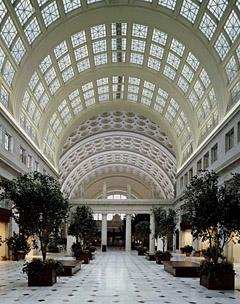
Washington's Union Station is celebrating its 100th anniversary
 |
However, Union Station is far more than just a transportation hub. In addition to the tour of the magnificent neoclassical building, it attracts crowds of visitors with over a hundred shops selling luxury goods, top-notch restaurants, a giant hall with dozens of fast-food stalls, and even a multiplex cinema with nine screens. On average, around 90,000 people pass through here every day, which totals over 32 million annually.
The station began operating in 1907, but was only fully completed a year later. In the heyday of railway travel, it was the gateway to the capital of the United States, through which future presidents arrived for their inaugurations, or where heads of foreign states first stepped onto American soil. Presidential inaugural balls are still held there every four years.
The history of Union Station mirrored the history of rail travel. After the peak of prosperity, lean years followed post-World War II, when highways and later air travel began to compete with railroads. Many railway buildings across the United States fell victim to this phase of development, including the famous Pennsylvania Station in New York, which had to make way for modern construction in 1964.
In contrast, Washington's Union Station had a happier fate and today represents one of the most successful adaptations of train station spaces in the world while retaining its original purpose. It has been 20 years since the reconstruction that gave the building its current interior layout was completed, a milestone that is also being celebrated this weekend because without the extensive renovations of the 1980s, the centenary would likely not be celebrated at all.
The decline of passenger rail service in the second half of the last century raised doubts about what the magnificent building near the Capitol should be used for. In 1958, it faced the threat of demolition, and there were considerations to build a modern office building at its prestigious location. A few years later, there were proposals for it to serve as a cultural venue, but ultimately, the Kennedy Center was created on the banks of the Potomac for that purpose. The plan to establish a railway museum in the station also did not materialize.
Only the approaching celebrations of the 200th anniversary of the founding of the United States breathed new life into Union Station. The visitor center project with an audiovisual program opened on July 4, 1976, but caused significant damage to the building, including the destroyed marble floor in the entrance hall. The National Visitor Center with a theater, derisively referred to as "the pit," struggled with public disinterest and a lack of parking. After two years, authorities determined that the building had structural problems, the exhibition was closed, and the station was boarded up.
In 1981, extensive renovations began, and like the mythical Phoenix, the new station was born, once again serving travelers. Thanks to its location in the city center, it offers convenient transportation to suburban areas as well as to distant cities like Baltimore, Philadelphia, New York, or Boston. The high-speed Acela train from the state-owned Amtrak company reaches downtown New York, 350 kilometers away, in just under three hours, which is at least an hour less than the journey by car. However, the ticket price reflects that, costing up to $215, which is about 3,600 crowns one way.
The current centennial anniversary attracted tens of thousands of guests to Union Station over the weekend. The main attractions included steam locomotives from the days of conquering the Wild West, historical passenger cars, postal cars, and modern trains.
Even after a hundred years, the station proves to be an integral part of the urban fabric. It combines its original purpose with contemporary interests in culture and consumer entertainment. It is no wonder that out of the 32 million visitors each year, one in four is a tourist.
The English translation is powered by AI tool. Switch to Czech to view the original text source.











